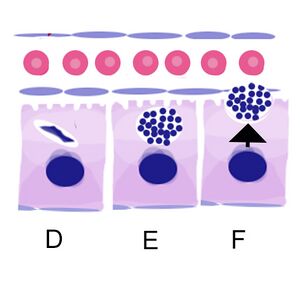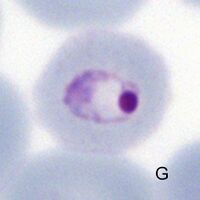Pre-erythrocytic (liver) stage
From haematologyetc.co.uk
Navigation
(click blue highlighted text to return to page)
Malaria main index
>Basic malaria biology
>>This page: Pre-erythrocytic (liver) stage
| The initial infection of the host |
The initial mosquito bite (Image A): blood from the host is taken through as mosquito mouthparts (m) from small vessels (v). At the same time fluid from mosquito salivary glands passes into the vessel. If a mosquitos is host to the malaria organism then parasites enter the blood with this saliva (in the form of "sporozoites" (sp)).
| Infection and replication in liver |
The sporozoites that have entered the blood then pass through the blood vessel and into the cells of the liver (B). They may pass through multiple cells but then remain in a single liver cell (C).
| From liver to blood |
The parasites in liver cells (D) then undergo repeated cycles of asexual replication (E) to form schizonts which are similar to the schizont stage in blood. At the end of the process the “merozoites” that are formed are released into blood (F).
They then infect red cells and now have the typical appearance of early trophozoite (G).
| Relevance of hepatic stage to clinical biology |
The incubation period before symptoms around 1-4 weeks during this time parasites will not be detected in blood P.ovale and P.vivax form hynozoites (term derived from “sleeping anima”) which may reactivate typically in less than a year to cause a late infection A single infected bite may be enough



